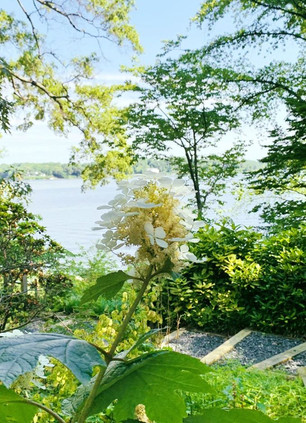Botanist's Lens: Happy Hyrdrangeas
- Meenal Harankhedkar, Director of Horticulture
- Jun 26, 2020
- 2 min read
Hydra Happy

"Hydra" in Hydrangea is derived from "Hydros," which in Greek refers to water (and "Angeoin," which refers to the fruit capsule that resembles a vessel). Hydra happy, is how I remember Hydrangeas' affinity for water: hydros makes hydras happy!
Hydrangeas require a moist, well drained soil; not wet feet. It is not as much that over watering that will hurt a hydrangea, but they are the quickest to show signs for underwatering. They also have the ability to absorb water fastest, so even if your hydrangeas look droopy/dead on hot summer days, load them up with hydros, and hydras will be happy again.

I like pink, but you like blue?
No problem! With breeders being extremely busy with this long lasting panicle bloomer, there are specific varieties wherein you can pick flowers to be pink/blue. “For H. macrophylla and H. serrata cultivars, the flower color can be determined by the relative acidity of the soil: an acidic soil, will have available aluminum ions and typically produce flowers that are blue to purple, whereas an alkaline soil will tie up aluminum ions and result in pink or red flowers.” Learn more here and here.

Pruning and Sun
Hydrangeas do not need much pruning. The heavier you prune, the fewer will be the blooms with inflorescence size being larger. For woodland gardens like those at London Town, the native H. quercifolia, Oak leaf hydrangea, is a stunning addition in the deep shade. But the best show stopper Hydrangea is in the ornamental garden in full sun, 'Limelight'.
Mopheads, panicles, lacecaps
Hydrangeas are a perfect addition for a summer garden, be it mid day or dusk. Their large panicle blooms will certainly stand out above the rest. Mopheads, panicles, lacecaps... there are ample to choose from, here is a good link to some key varieties: https://cdn.canr.udel.edu/…/1202…/2014_Hydrangea_Feature.pdf


Sterile vs Fertile Flowers
Next time you notice a hydrangea blooming, go up close to see the true fertile flowers tucked near the showier sterile flowers. Sterile flowers attract pollinators, and fertile ones feed them. There are ample varieties with a mix of both, but beware of the showiest blooms, for the fertile feeder flowers might be handful. In the wild varieties, the sterile flowers are fewer, and it doesn't take much to attract the pollinators, but in nurseries you might end up finding more of the showier sterile flowers. Great for color, but not so much for the bees and the birds.
Newer varieties of hydrangeas blooms last for a long time. You can bring them in as cut flowers, or even dry and color them to use them indoor in winter. But remember when you bring them in, "hydro makes hydras happy." Even if blooms dry out as you bring them in, add sugar and bleach to water and watch your hydras perk up!
Hyrdros makes hydras happy, and many gardens seem much happier!









In PolyTrack, racing isn’t on the ground — it’s in the air. The glowing tracks twist through the clouds, daring you to stay balanced at top speed. Every second tests your timing and skill. One wrong move, and you’re falling fast — but that’s what makes it thrilling.
The Ladli Behna Yojana empowers women in Madhya Pradesh by offering a monthly financial grant to support their economic independence and improve their living standards.
You should get closer to the hydrangea the retro bowl 26 next time you see it flowering so that you may view the genuine fertile blossoms that are nestled away near the showier sterile flowers.
Love this memory trick for hydrangeas! Keeping them happy definitely takes some strategic planning to ensure they thrive. It almost reminds me of the strategic thinking needed in a game like age of war to keep your base secure. So clever!
Another great game is skribbl io, which is fun for everyone and lets you try out more choices.